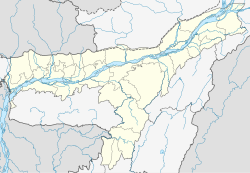Hailakandi
|
Hailakandi Bengali: হাইলাকান্দি |
|
|---|---|
| Town, District Headquarter | |
| Location in Assam, India | |
| Coordinates: 24°41′N 92°34′E / 24.68°N 92.57°ECoordinates: 24°41′N 92°34′E / 24.68°N 92.57°E | |
| Country | India |
| State | Assam |
| District | Hailakandi |
| District created | 01-10-1989 |
| Government | |
| • Body | Hailakandi Municipality Board |
| Area | |
| • Total | 1,327 km2 (512 sq mi) |
| Elevation | 21 m (69 ft) |
| Population (2011) | |
| • Total | 659,260 |
| • Density | 497/km2 (1,290/sq mi) |
| Languages | |
| • Official | Bangla |
| Time zone | IST (UTC+5:30) |
| PIN | 788XXX |
| Telephone code | 91 - (0) 03844 |
| Vehicle registration | AS-24 |
| Website | hailakandi |
Hailakandi (pron:ˈhaɪləˌkʌndi) (Bengali: হাইলাকান্দি) is a town and the district headquarters of Hailakandi district in the Indian state of Assam. The Hailakandi district is one of the three districts of Southern Assam i.e. Barak Valley.
Hailakandi is located at 24°41′N 92°34′E / 24.68°N 92.57°E. The area of Hailakandi town is 4.55 km2 according to the 2001 census. It has an average elevation of 21 metres (68 feet). It has an area of 1326.10 square kilometres. Out of this, more than 50% (i.e. 783.15 km2) is forested area. The forest comprises 781.45 km2 of reserve forest and 1.70 km2 of proposed reserved forest. The district has an inter-state border with Mizoram on its south having a length of 76 km, and an inter-district border on the other sides with Karimganj and Cachar districts.
According to the 2011 census, the population of the district was 659,296 while the population growth rate was 21.45%.
The prime geographical character that forms the topographical features of Hailakandi is the river Barak and its tributaries. These rivers spread rich alluvial plains across the length and breadth of three southernmost districts of Assam. There are two major rivers flowing through the district, Katakhal and Dhaleswari. There are also two small rivers named Pola and Jita. These four rivers are fed by seven tributaries that flow through the district.
There are two reserved forests in Hailakandi District, the inner line reserved forest and the Katakhal reserved forest. These were once rich in wildlife but this is now vanishing due to human onslaught. Rare species have been recorded, including the hoolock gibbon, Phayre's leaf monkey, pig-tailed macaque, white-winged wood duck, and purple wood pigeon. The southern part was also recommended as 'Dhaleswari' wildlife sanctuary.
...
Wikipedia


